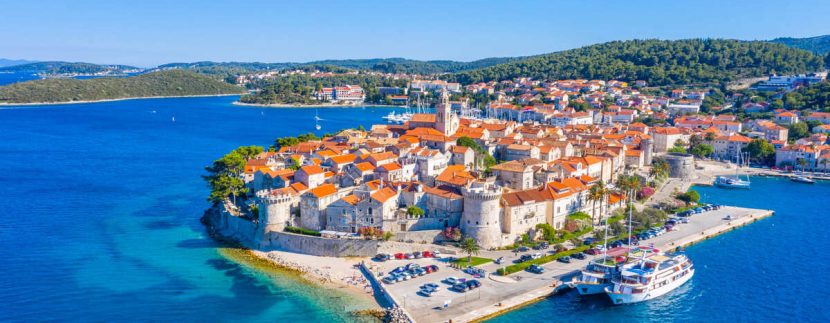Croatia Is The Most Popular Summer Destination In Europe Right Now

[ad_1]
Last Updated
Tourists are flying back to Europe in droves now that the continent’s doors have flung open and normality is fully reinstated for the first time in years, and while new visitor peaks are being reported all over the continent, the beautiful Balkan nation of Croatia is outperforming the rest in popularity.
Already a trendy destination prior to the health crisis, Croatia’s Dalmatian Coast has re-emerged from the pandemic years as a major Mediterranean competitor, threatening to overthrow Spain’s, Italy’s, and Greece’s decades-long hegemony in the basin.
In fact, it may well be the Med’s new regional leader:

Croatia Is The Most Sought-After Med Vacation
As reported by Total Croatia News, Italy’s Tuscany and France’s Cote d’Azur should ‘move over’ as the Dalmatian Coast had registered over 7.5 million overnight stays in August 2022 alone, when Europe was still partly shut down, and the wider reopening of borders was still months away from happening.
This easily places Croatia at the top of Europe’s post-COVID recovery race, largely due to the country’s relaxed border policies – they were receptive to American guests throughout most of the crisis – and major efforts in improving the tourist experience.
In the meantime, major city breaks like Berlin, Prague, and Austria’s stately Vienna were ‘still in the red’ in the short-term accommodation category, according to data shared by Eurostat, with fewer reservations on all major booking platforms, including AirBnB, Booking, Expedia, and TripAdvisor.

This year, coastal Croatia might be poised for yet another historic growth, as it posts an additional 16% increase in tourism for the first half of 2023. Overall, there have been 6.7 million arrivals, and more than 27.3 million overnight stays by the end of June, according to the Croatian Tourism Board.
Overnight stays have officially surpassed 2019’s pre-pandemic levels by 4%, proving Croatian tourism is on the up, and well ahead of other Mediterranean nations, but how did it get so popular so fast?
A Nation Reborn
Croatia is currently Europe’s most sought-after destination, but it wasn’t always like that.
Top 5 Travel Insurance Plans For 2023 Starting At $10 Per Week

An ancient nation straddling the Adriatic Sea, it has a complex History intertwined with that of its closest neighbors. Prior to the nineties, Croatia was in fact part of the now-dissolved Yugoslavia, a communist state in Southeastern Europe comprising a majority of modern-day Balkan countries.
When Yugoslavia broke up, numerous parts of newly-founded Croatia essentially became a no-go zone, as war ravaged the peninsula and militia took over settlements, not to mention the constant shelling of major cities.
Coastal spots like Dubrovnik, famous for its well-preserved medieval sea fortifications, were badly damaged by bombing, and it would take a good number of years until the situation normalized and the new Balkan states came to an agreement over the drawing of new borders and a ceasefire.

The Yugoslav war has had a long-lasting effect on post-Yugoslav states, most notably Kosovo, now one of Europe’s poorest territories, but defying odds, Croatia rose out of the ashes stronger.
By the mid-2000s, it was already back to being a popular beach getaway, most notably among Germans, Austrians, and Slovenians.
As investment in infrastructure intensified, and the country made great strides in its path towards the European Union, achieving member status in 2013 and reaching the Eurozone earlier this year, it firmly placed itself among Europe’s most successful post-war sovereign states.
It went from being a nation torn by war, largely avoided by risk-averse visitors, to a subtropical paradise full of promise with a growing expat community in only a few decades.
Game of Thrones Territory

Additionally, interest in Croatia, or more specifically, the Dalmatian Coast, has been rekindled following the debut of Game of Thrones (commonly shortened to GOT), HBO’s greatest TV phenomenon so far, and a fantastical epic filmed partly in Southern Croatia.
Since then, GOT enthusiasts have been flocking to Dubrovnik, or as they call it, ‘King’s Landing’, to trace the steps of their favorite TV characters and take in the city’s charming medieval atmosphere.
As if that weren’t enough, Croatia has excelled itself in opening the long-anticipated Peljesac Bridge in record time, cutting down wait times for drivers reaching Dubrovnik from Northern Dalmatia.
Previously, drivers were required to pass through the neighboring country of Bosnia and Herzegovina, as the 5-mile Bosnian ‘Neum corridor’, its only access to the sea, infamously disrupts the Croatian coastline’s contiguity.

Prior to the opening of the bridge, tourists heading to Dubrovnik were required to exit Croatia, undergo border screening at Neum, exit Bosnia, and re-enter Croatia a second time in order to proceed with their travels unless they were arriving by boat.
This usually added hours to what’s supposed to be a short drive, especially in peak times during summer, when road congestion was heavy. Now, tourists enjoy a much smoother experience, bypassing Bosnia altogether.
Less Borders, Better Tourist Experience
On top of that, Croatia has recently ascended into Europe’s border-free Schengen Zone. This means there will no longer be any border checks carried out between Croatia and 26 other Schengen states, like Slovenia, Austria, Hungary, France, Italy, and a majority of EU members.

This greatly facilitates travel, as being stopped at the border to present documentation is not needed, and brings Croatia closer to its European counterparts.
Finally, this decade saw the launch of the Republic of Croatia’s first-ever transcontinental flights, when a passenger plane originating from Newark, in the U.S., touched down in Dubrovnik for the tourist season.
Since then, regular seasonal flights have been offered between both hubs, bridging the wide gap that kept American and Croatian aviation apart and making it easier for U.S. nationals to visit the Mediterranean’s most iconic ancient port city.

Taking this information into account, it’s truly no surprise that, last year, the Adriatic Coast of Croatia, alternatively called Dalmatia, was the most popular summer destination in Europe, leading bookings from June through September.
As reported by EU data analysts, Adriatic Croatia registered more overnight stays than ‘entire countries’ last year, and it will almost certainly see further growth in 2023.
Traveler Alert: Don’t Forget Travel Insurance For Your Next Trip!
↓ Join Our Community ↓
The Travel Off Path Community FB group has all the latest reopening news, conversations, and Q&A’s happening daily!

SUBSCRIBE TO OUR LATEST POSTS
Enter your email address to subscribe to Travel Off Path’s latest breaking travel news, straight to your inbox.
This article originally appeared on TravelOffPath.com
[ad_2]
Source link






